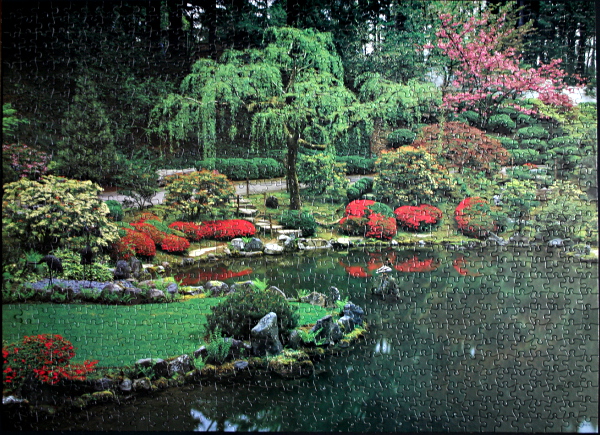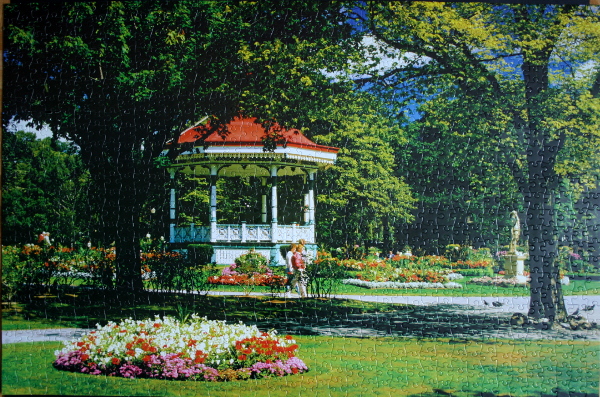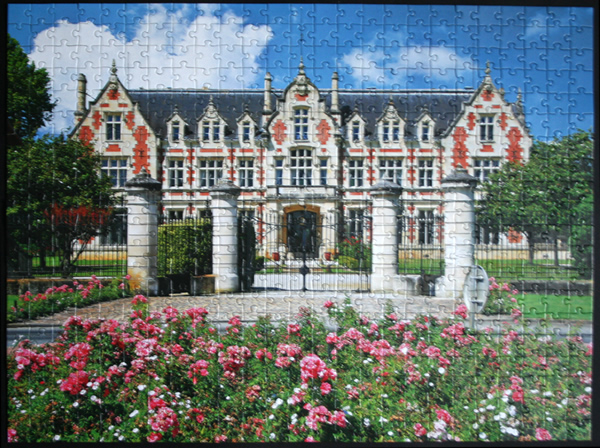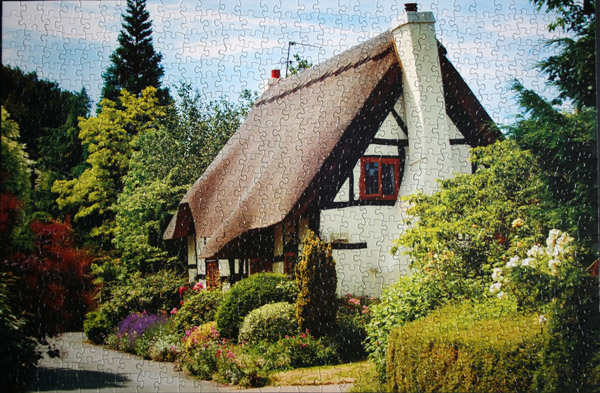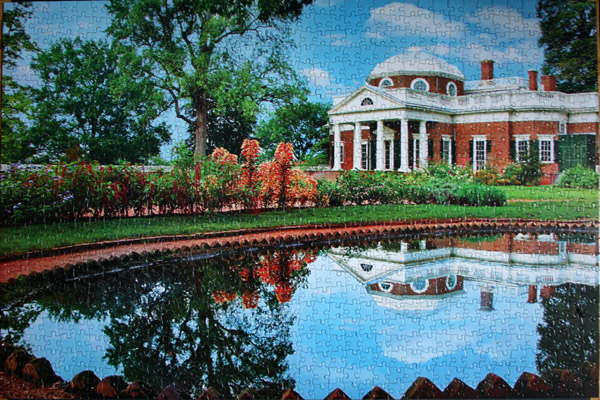Tag: garden
Photo: Lilac white constellations, March 15, 2013
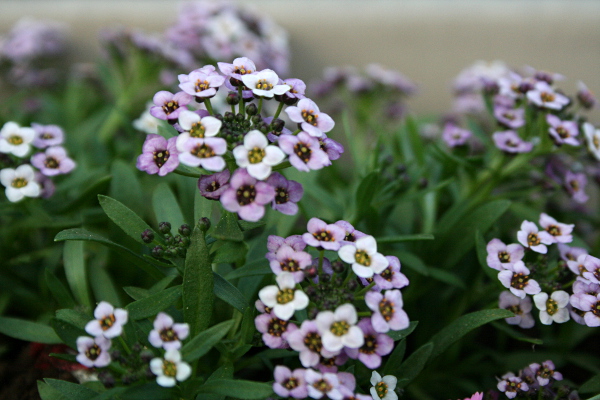
Photo: Blood Red Lily on Green, May 17, 2013

Photo: Purple Flowers on Green, May 17, 2013
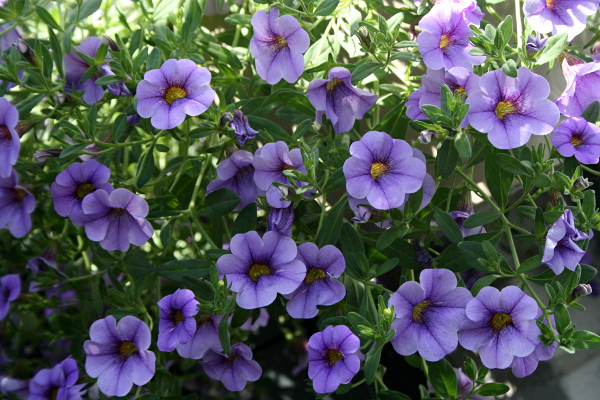
Puzzle: Waterfall in a garden
Size: 750 pieces
Dimensions: 43.81 cm x 58.42 cm
Producer: MB Puzzle, Oxford series, 1999, C4848-18
Puzzle: Despite the large regions of green leaves and small flowers, this puzzle is relatively easy to do due to the waterfall separating the two parts at the top, and to the small number of pieces. Waterfall, the rock behind it, the basin, and the yellow spot are a good start. From that point on, darker regions, flowers, and trees can follow. Not a trivial puzzle, but quite enjoyable. Good lighting is a plus.
Notes: No discernable name on the puzzle box.
Puzzle: Japanese Garden, Portland, OR, USA
Size: 1000 pieces
Dimensions: 51.12 cm x 69.85 cm
Producer: Guild Puzzle, 1995, 4710-12
Puzzle: Not a trivial puzzle, but a very enjoyable one. Daylight is a bonus. The good starting points are red bushes with their reflections, green patch of grass, shrubs with yellow and orange flowers, the rocks, the path, and the stairs. Pink flower tree, dark red bush under it, and light green willow are good focal points as well. From there, dark green tree regions, black and white patches of the sky, and the water complete the puzzle.
Notes: Willows, sallows, and osiers form the genus Salix, around 400 species of deciduous trees and shrubs, found primarily on moist soils in cold and temperate regions of the Northern Hemisphere. Most species are known as willow, but some narrow-leaved shrub species are called osier, and some broader-leaved species are referred to as sallow. Some willows (particularly arctic and alpine species) are low-growing or creeping shrubs; for example, the dwarf willow (Salix herbacea) rarely exceeds 6 cm in height, though it spreads widely across the ground. [Wiki]
Puzzle: Public Garden
Size: 1000 pieces
Dimensions: 73 cm x 48.57 cm
Producer: Sure-Lox, The Canadian Group, Glorious Gardens series, 2011, #40660-6
Puzzle: The gazebo, flowerbed, and grey walkways are a good place to start. Tree trunk on the right can serve as a vertical guideline. The blue of the sky, smaller garden details, and the green of the lawns can follow. From there, the remaining black parts can pave the way to the green tree leaves. Overall a pleasant puzzle, although my copy was strangely cut and unlike the usual Sure-Lox fit, the pieces did not stick together very well.
Notes: A garden is a planned space, usually outdoors, set aside for the display, cultivation, and enjoyment of plants and other forms of nature. The garden can incorporate both natural and man-made materials. Western gardens are almost universally based on plants, with garden often signifying a shortened form of botanical garden.
Some traditional types of eastern gardens, such as Zen gardens, use plants such as parsley. Xeriscape gardens use local native plants that do not require irrigation or extensive use of other resources while still providing the benefits of a garden environment. Gardens may exhibit structural enhancements, sometimes called follies, including water features such as fountains, ponds (with or without fish), waterfalls or creeks, dry creek beds, statuary, arbors, trellises and more. [Wiki]
Puzzle: Apple Picking by Betty Wittwe
Size: 1000 pieces
Dimensions: 73 cm x 48.57 cm
Artist: Betty Wittwe – Born in Metz, France in 1959, Wittwe graduated from the School of Beaux Arts and majored in Plastic Arts in 1979. Her strong inclination for performing art has influenced her first canvases featuring musical and dance performances, circus …
Although Wittwe is still adept at painting musicians scenes and ballerinas, she also developed great skills for subjects such as landscapes, garden views, interior scenes,… Inspired by the peaceful atmosphere of her farmhouse in Provence, she uses spontaneous brushwork. Light is provided by the choice of her bright and vivid colors.
She masters her technique and focuses her effects on expressing emotions. Her vivid colors and strong brush work give life and vitality to her paintings. She gives us the possibility to dream and to escape. Recipient of best of show place awards in Paris French Fine Art Exhibition, her reputation crossed the Atlantic in 1997 when she started to exhibit at a major Madison Avenue gallery in New York and Beverly Hills. [Pejman Gallery site]
Producer: Sure-Lox, The Canadian Group, Celebration of Women series, 2009, #40888PAL
Notes: This series celebrates all women with bright colorful images of days gone by, sweet memories and priceless friendships. Our featured artists capture great moments of women – mothers, sisters, daughters and friends. It celebrates the qualities they possess – their graces, inner strength, love, forgiveness, endurance and constant perseverance. [Puzzle box]
Puzzle: The bright colours of women’s dresses and the dark of the tree trunks are logical regions to begin assembly. After that, the sky, the building near horizon, and the apple box are distinct areas. The rest of the puzzle consists of a blend of green, blue, and yellow colours, presenting a bit more of a challenge.
Puzzle: Wine Cellar Château Cantenac-Brown, France
Size: 500 pieces
Dimensions: 46 cm x 61 cm
Producer: The Lafayette Puzzle Factory, Colorluxe, 2012, #3091
Notes: This puzzle is a pleasure to do – the most complicated area is the flowers, but having placed everything else, that only leaves about 2-3 rows of pieces. I have started with the sky and the building top, followed by the pillars, the trees, grass, gate and the ground in front of it, the building, and finished with the flowers. Sat down to puzzle for half an hour, got up about 2 hours later with the puzzle completed. This is a relaxing one.
Château Cantenac-Brown: Château Cantenac-Brown is a winery in the Margaux appellation of the Bordeaux region of France. The wine produced here was classified as one of fourteen Troisièmes Crus (Third Growths) in the historic Bordeaux Wine Official Classification of 1855. The Chateau has 104 acres (0.42 km2) planted with Cabernet Sauvignon, Merlot and Cabernet Franc. The Chateau produces a second wine labeled as Brio de Cantenac-Brown. [Wiki]
Puzzle: Fenced Flower Garden
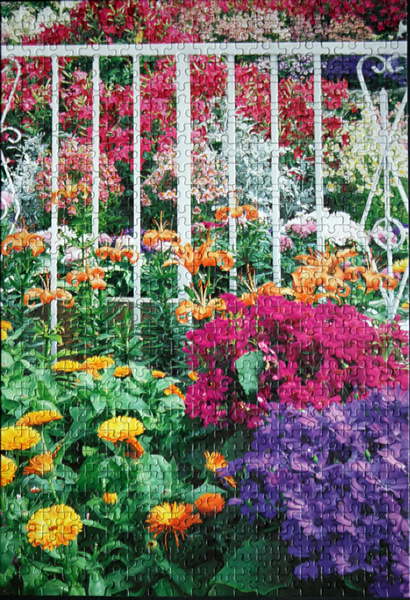
Size: 550 pieces
Dimensions: 33cm x 48.3cm
Producer: RoseArt, 1997, No. 99999RA
Puzzle: Not a trivial puzzle due to the shape and fit of the pieces, but not significantly difficult as it is only 550 pieces. The most logical part to tackle first is the fence, providing vertical and horizontal guidelines to the variety of small flower patches behind it. Once the fence is done, yellow flowers and orange lillies are the easiest to complete. The bottom right purple batch of flowers and the fuchsia one above are equally good to take on next, and the few remaining green pieces can then easily be placed.
Fence: A fence is a freestanding structure designed to restrict or prevent movement across a boundary. Fences are generally distinguished from walls by the lightness of their construction and their purpose. Walls are usually barriers made from solid brick or concrete, blocking vision as well as passage, while fences are used more frequently to provide visual sectioning of spaces. [Wiki]
Puzzle: Pie baking day by Janet Kruskamp
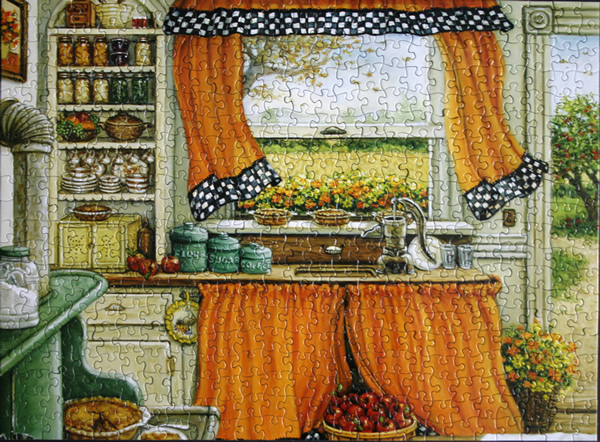
Size: 500 pieces
Dimensions: 45.26cm x 35.56cm
Producer: Sure-Lox, The Canadian Group, Country Kitchen series, 2011, #42225-3
Artist: Janet Kruskamp
Puzzle: The orange curtains and the checkered parts are an easy place to start. Flowers on the window sill, apples, edge of the green table, sky, and tree can follow. The pipe, door frame, garden, and beige cupboard can be finished next, leaving the cans, dishes, and a few other small areas to complete. Very pleasant and staightforward puzzle. It also includes a shortbread cookies recipe and a red puzzle piece cookie cutter.
Baking: In ancient history, the first evidence of baking occurred when humans took wild grass grains, soaked them in water, and mixed everything together, mashing it into a kind of broth-like paste. The paste was cooked by pouring it onto a flat, hot rock, resulting in a bread-like substance. Later, this paste was roasted on hot embers, which made bread-making easier, as it could now be made anytime fire was created.
In ancient history, the first evidence of baking occurred when humans took wild grass grains, soaked them in water, and mixed everything together, mashing it into a kind of broth-like paste. The paste was cooked by pouring it onto a flat, hot rock, resulting in a bread-like substance. Later, this paste was roasted on hot embers, which made bread-making easier, as it could now be made anytime fire was created. [Wiki]
Puzzle: Blue Stove by Janet Kruskamp
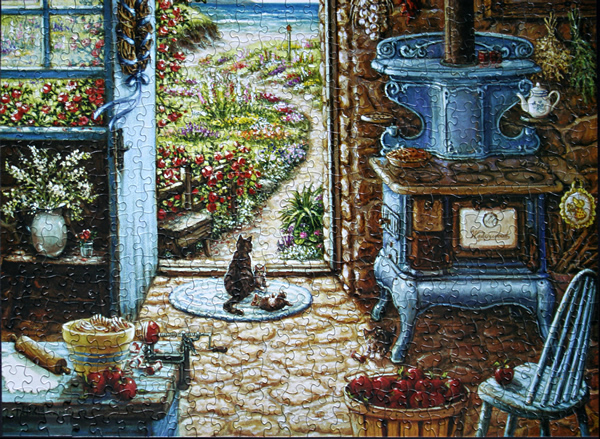
Size: 500 pieces
Dimensions: 45.26cm x 35.56cm
Producer: Sure-Lox, The Canadian Group, Country Kitchen series, 2011, #42225-1
Artist: Janet Kruskamp
Puzzle: I have started this one with the blue regions: the door, the stove, the rug, and the chair. Window frame, white flowers in the vase, red apples, bowl on the table, the vase, the plaque on the stove, and the garden path are smaller self-contained regions. The flower garden and the light part of the floor easily fall into place, and the brown under the vase and all around and on the stove are the more subtle parts left over. Not a hard puzzle to do, it helps to have natural light at the end. The puzzle includes a shortbread cookies recipe and a red puzzle piece cookie cutter.
Stove: The Old English word stofa meant any individual enclosed space, such as a room, and ‘stove’ is still occasionally used in that sense, as in ‘stoved in’. Until well into the 19th century ‘stove’ was used to mean a single heated room, so that Joseph Bank’s assertion that he ‘placed his most precious plants in the stove’ or Rene Descarte’s observation that he got ‘his greatest philosophical inspiration while sitting inside a stove’ are not as odd as they first seem.
In its earliest attestation, cooking was done by roasting meat and tubers in an open fire. Pottery and other cooking vessels may be placed directly on an open fire, but setting the vessel on a support, as simple as a base of three stones, resulted in a stove. The three-stone stove is still widely used around the world. In some areas it developed into a U-shaped dried mud or brick enclosure with the opening in the front for fuel and air, sometimes with a second smaller hole at the rear. [Wiki]
Puzzle: Canning Day by Janet Kruskamp

Size: 500 pieces
Dimensions: 45.26cm x 35.56cm
Producer: Sure-Lox, The Canadian Group, Country Kitchen series, 2011, #42225-2
Artist: Janet Kruskamp
Puzzle: A logical starting point are the checkered curtains, followed by the yellow batches of colour and the stove. Floor boards, white table, garden path and flowers, the patches of sky, and the vegetables make stand-alone regions that are easy to put together. Door frame and window frame logically fall into place. The rug, corn, and places under the stove follow, to leave only the cupboards and a few dark areas. Easy and fast puzzle to do. It also includes a shortbread cookies recipe and a red puzzle piece cookie cutter.
Canning: Canning is a method of preserving food in which the food contents are processed and sealed in an airtight container. Canning provides a typical shelf life ranging from one to five years, although under specific circumstances a freeze-dried canned product, such as canned, dried lentils, can last as long as 30 years in an edible state. In 1795 the French military offered a cash prize of 12,000 francs for a new method to preserve food. Nicolas Appert suggested canning and the process was first proven in 1806 in test with the French navy and the prize awarded in 1809 or 1810. The packaging prevents microorganisms from entering and proliferating inside.
To prevent the food from being spoiled before and during containment, a number of methods are used: pasteurisation, boiling (and other applications of high temperature over a period of time), refrigeration, freezing, drying, vacuum treatment, antimicrobial agents that are natural to the recipe of the foods being preserved, a sufficient dose of ionizing radiation, submersion in a strong saline solution, acid, base, osmotically extreme (for example very sugary) or other microbially-challenging environments. [Wiki]
Puzzle: La Roche Courbon Castle, France
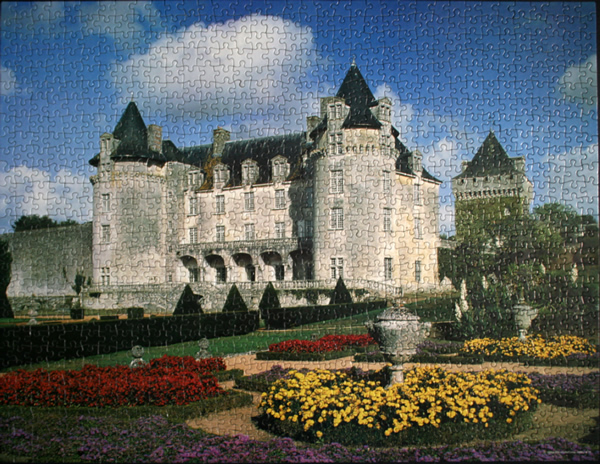
Size: 1000 pieces
Dimensions: 51.12cm x 66.52cm
Producer: Big Ben, MB Puzzles, Hasbro, 2007
Notes: Chateau de la Roche Courbon is a large chateau, developed from an earlier castle, in the Charente-Maritime departement of France. It is in the commune of Saint-Porchaire between Saintes and Rochefort.
A castle was built around 1475 by Jehan de Latour, on site which had been inhabited since prehistoric times. In the 17th century, the Courbon family, which had occupied the castle for two centuries, transformed it into a more comfortable residence. More alterations were made in the 18th century, but it was eventually sold in 1817 and then abandoned. It was purchased in 1920 by Paul Chenereau, who restored the chateau and its gardens. The chateau is still owned and inhabited by his descendants.
The gardens include orchard, flower garden, geometrical flower beds and lawns surrounding a small lake (‘mirror pool’). The River Bruant flows through the gardens, feeding the water features. Beyond that, an ornamental staircase leads to higher ground, on the far side of the river. [Wiki]
Puzzle: Thatched Cottage
Size: 750 pieces
Dimensions: 59.7 cm x 39.4 cm
Producer: The Canadian Group, Sure-Lox, Photo Gallery 10 puzzle pack, #42510-57
Notes: The puzzle producer has not once again indicated the location of the cottage.
Although thatch is popular in Germany, The Netherlands, Denmark, Belgium and Ireland, there are more thatched roofs in the United Kingdom than in any other European country. Good quality straw thatch can last for more than 45–50 years when applied by a skilled thatcher.
Over 250 roofs in Southern England have base coats of thatch that were applied over 500 years ago, providing direct evidence of the types of materials that were used for thatching in the medieval period. Almost all of these roofs are thatched with wheat, rye, or a ‘maslin’ mixture of both. Medieval wheat grew to almost 1.8m tall in very poor soils and produced durable straw for the roof and grain for baking bread. [Wiki]
Puzzle: Mansion and garden
Size: 1000 pieces
Dimensions: 73cm x 48.5cm
Producer: The Canadian Group, Sure-Lox, Images series, #43670-14
Notes: A mansion is a very large dwelling house. U.S. real estate brokers define a mansion as a dwelling of over 740 square meters. A traditional European mansion was defined as a house which contained a ballroom and many bedrooms. Today, however, there is no formal definition beyond being a large and well-appointed house.
In the Roman Empire, a mansio was an official stopping place on a Roman road, or via, where cities sprang up, and where the villas of provincial officials came to be placed. The Scots word “manse” originally defined a property large enough for the Minister of the parish to maintain himself, but a mansion is no longer self-sustaining in this way (compare a Roman or medieval villa). ‘Manor’ comes from the same root — territorial holdings granted to a lord who would remain there — hence it can be seen how the word ‘Mansion’ came to have its meaning. [Wiki]
Puzzle: At the Fountain by Barbara Mock
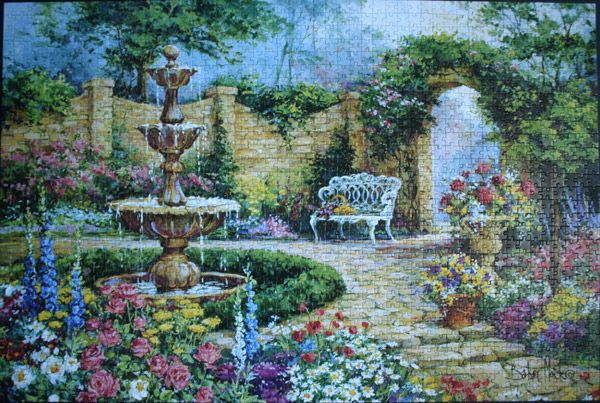
Size: 1500 pieces Dimensions: 60cm x 90cm Producer: Jumbo International, Amsterdam, #00681 Artist: Barbara Mock Notes: A fountain (from the Latin “fons” or “fontis”, a source or spring) is a piece of architecture which pours water into a basin or jets it into the air either to supply drinking water or for decorative or dramatic effect. Fountains were originally purely functional, connected to springs or aqueducts and used to provide drinking water and water for bathing and washing to the residents of cities, towns and villages. Until the late 19th century most fountains operated by gravity, and needed a source of water higher than the fountain, such as a reservoir or aqueduct, to make the water flow or jet into the air. In addition to providing drinking water, fountains were used for decoration and to celebrate their builders. Roman fountains were decorated with bronze or stone masks of animals or heroes. In the Middle Ages, Moorish and Muslim garden designers used fountains to create miniature versions of the gardens of paradise. King Louis XIV of France used fountains in the Gardens of Versailles to illustrate his power over nature. The baroque decorative fountains of Rome in the 17th and 18th centuries marked the arrival point of restored Roman aqueducts and glorified the Popes who built them. [Wiki]
Puzzle: Cholmondeley Castle

Size: 1000 pieces
Dimensions: 73cm x 48.5cm
Producer: Sure-Lox, The Canadian Group
Notes: Cholmondeley Castle is a country house in the civil parish of Cholmondeley, Cheshire, England. It is surrounded by a 7,500 acres estate.
In the 18th century Hugh Cholmondeley, 1st Earl of Cholmondeley had created gardens around the house, both kitchen gardens and orchards to provide food for the household, and also pleasure gardens. The pleasure gardens would have been formal in style as they were laid out by George London. The ironworker Jean Tijou produced an iron entrance gate to the gardens, but this was moved to Houghton Hall in Norfolk by the 4th Earl. John van Nost designed a fountain for the garden. The garden also contained a bowling green and an aviary. The 4th Earl brought in William Emes to redesign the garden who, according to the fashion of the day, buried London’s work under a landscape park. [Wiki]
Puzzle: Endless Dreams by Alan Giana
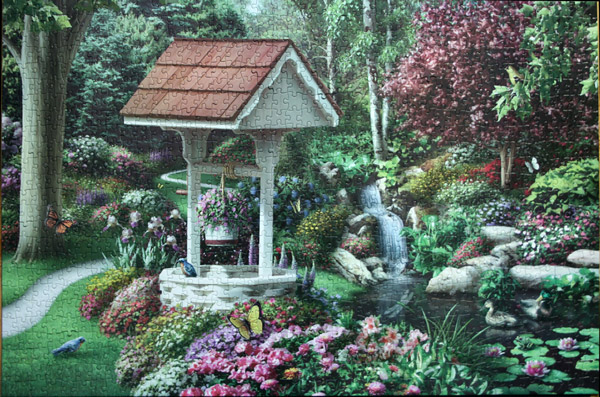
Size: 1000 pieces
Dimensions: 73cm x 48.6cm
Producer: Sure-Lox, The Canadian Group
Artist: Alan Giana
Painting: http://www.muralsyourway.com/imag.aspx?sr=MMIAAG1040.jpg
Notes: Alan’s love of nature and the sea have always been a big part of his life. His appreciation for the beauty that surrounds us, even in our own backyards, plays an important part in creating the inspiring artwork he is known for today. Alan’s paintings of colorful paths, charming country hideaways, tranquil coastal waterways, and captivating Christmas scenes, bring us to peaceful places. Places where we can escape for a moment and appreciate all of the beauty around us. [Alan Giana’s site]
Puzzle: Metis International Garden Festival, Quebec, Canada
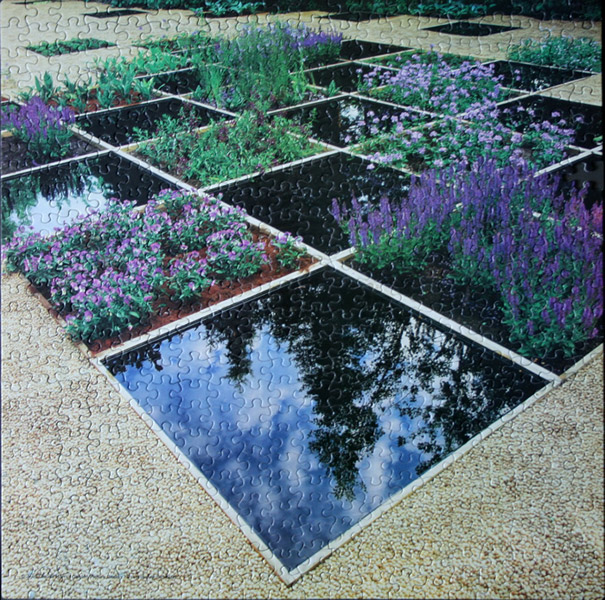
Size: 500 pieces
Dimensions: 40.64cm x 40.64cm
Producer: Hasbro, MB Puzzle, Big Ben series
Notes: The International Garden Festival is recognized as one of the most important events of its kind in North America and one of the leading annual garden festivals in the world. Since 2000, more than 900,000 visitors have explored 110 gardens created by over 220 designers from 15 countries.
The Festival is a unique forum for innovation and experimentation and an exceptional showcase and launching pad for participating designers from a host of disciplines. It provides an annual rendez-vous for admirers of contemporary gardens and design as well as offering a unique space for those involved in the renewal of this art form.
The site is bordered to the north by the St. Lawrence River, to the west by a woodland of deciduous trees, to the east by a large field and conifer forest. On occasion, gardens are installed on other parts of the Festival site and in the historic gardens. [Festival site]








